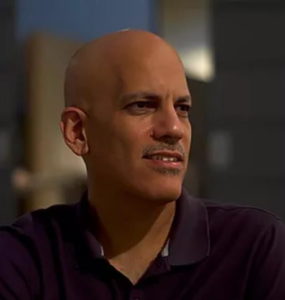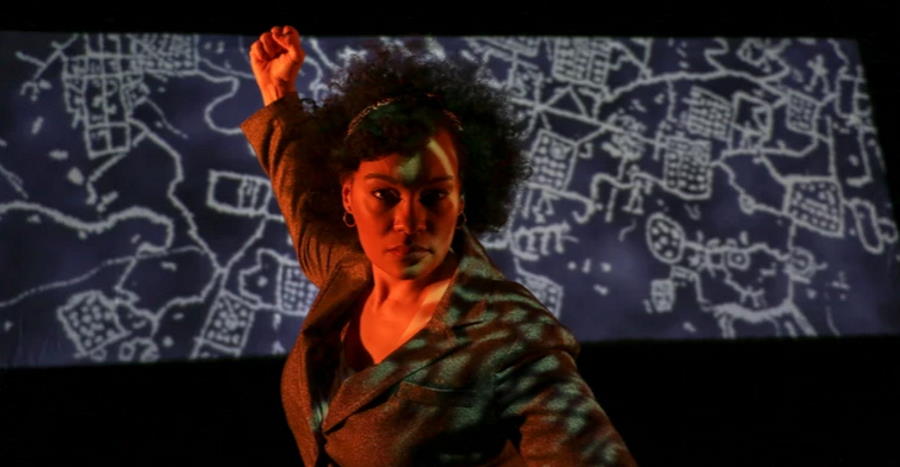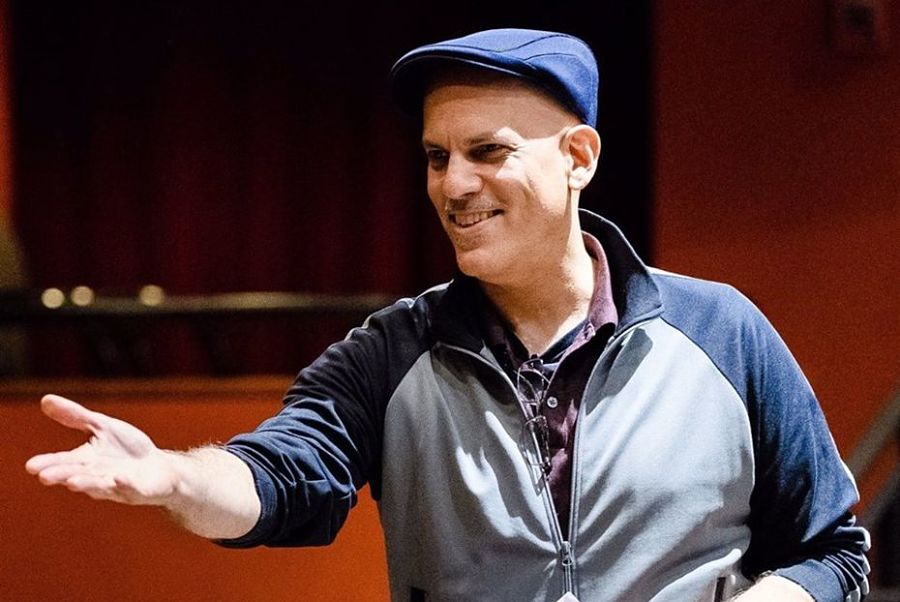Born in New York City and raised in the Boston area, Daniel Banks grew up in a household where he heard as many as five languages spoken. And although he only understood a fraction of the linguistic orchestra playing within his home, at a young age he discovered the plurality of communication and of community. This period of his life established a continuing passion for and connection to a global family. And soon after he began to weave a love for theatre into this extensive tapestry.
“There’s this sort of mystical bond that connects those of us who have been summoned to devote our lives to being an intermediary between society and individuals through the performing arts,” said Banks, who has created art and facilitated workshops in 23 countries and 35 states. He accepts TCG’s semi-annual Alan Schneider Director Award today.
When Banks talks about the spark that can ignite collaborations with such artists as writer/performer Christopher Rivas, composer/performer Maritri Garrett, and performer/community activist Ty Defoe, his eyes light up. “I think of the Old Testament story that our tribes were scattered in the desert,” he explains. “So I have this theory that we spend our life refinding our tribe.”
Banks also frequently collaborates with his husband, dancer/choreographer and educator Adam McKinney. Together they direct DNAWORKS, an arts and service organization dedicated to dialogue and healing through the arts. Their projects have an immersive sensibility that invites performer and audience to co-create the theatrical experience.
An ardent fan and sometime collaborator, I spoke with Daniel about his artistic journey, embodied experiences, and upcoming projects.

CHRISTINA ANDERSON: Can you pinpoint the “aha” moment that started you on your artistic journey?
DANIEL BANKS: The “aha” moment has actually been, to use the language of Adrienne Maree Brown, a constantly emerging process of moments. One very clear moment was when I was 15. I was in high school in Jerusalem and I was invited to a movement workshop held in a bomb shelter led by this amazing man, Barry Coughlan, a member of the Roy Hart Theater, who was my first theatre mentor. It was all professionals except me—I was the only teenager there. In that space there was a seriousness about theatre that, as a 15-year-old who had only done theatre in school, I had not experienced. There was an international-ness. A meaningfulness. Lives depended on it—there was actual bombing going on in Israel at the time. That workshop was the first time that it felt like it was about the art itself and that the art itself was part of life. Art was an indisputable necessity for life and living. And in that experience, there was this fully embodied moment where I could tell, “This is where I belong. These are my people.”
And the other “‘aha” moments?
Fast forward a few years, I was 19, and I saw Ping Chong’s Nosferatu at La MaMa. There was something so electric about his bravery and calling out inequities and privileges that were part of a New York scene at that time. I have really vivid memories of the ways that that was embodied in all elements of the production.
Another moment: The amazing actor, Ben Halley Jr., who was a mentor when I was in college, invited me to see him in Wole Soyinka’s Death and The King’s Horsemen at Lincoln Center. I had never experienced anything quite so 360-degree or immersive. That was a clear moment for me, that all of the things that I experienced as a young person culturally—music and dance and prayer and praise—all of these elements belonged in the theatre. They didn’t have to be left at the door. And that was very different from most of the theatre that I was exposed to growing up.
These and so many others were works that had an early influence on me because they relied upon the audience to be fully present—actually there, not invisible to the performers. They had to co-create the performance with the audience. And the spiritual commitment of the cast, using all of the performance elements and telling stories of dire import, telling life or death stories for their culture, for civilization. It was ritual theatre. These are the moments that I know were impactful because, when I remember them, they are still in my body.
You refer to those early impactful examples as embodied experiences—a full body sensation. When you approach work now as a director, does the piece have to impact you in a similar way?
Yes. I have this internal sensation of seeing the entire piece on super-fast-forward, and then it goes away. Then I have to rediscover what that sensation was. I think that initial feeling has something to do with what the piece has to say to an audience or society, or what the purpose of that piece is. The nice thing that I’ve learned over the years is that, just because I saw it in a way that I no longer have access to doesn’t mean that I have to actually go back and meticulously recreate that vision. Other people get involved and the energy shifts and people bring their own ideas. I wasn’t really interested in becoming an auteur director. I wanted to be in a cipher, a creative circle with an ensemble, facilitating a generative process, rather than the sole voice directing people.
Can you talk a bit about DNAWORKS?
Adam McKinney and I started DNAWORKS in 2006. When we first met in 2004, one of our first conversations was that we had similar experiences because we are ethnically ambiguous to a lot of people. And too many of our experiences in the arts were fielding questions about our ethnic or cultural identifications and not actually making work. We felt that there were not enough stories or representations of people of mixed or multiple heritages, or people who did not fit neatly into U.S. society’s prescribed boxes. And this lack of representation and opportunity contributed to misunderstandings about complex and intersectional identities of all kinds.
So we decided to take matters into our own hands and generate work to tell these stories. We very quickly found, I think it was no surprise to either of us, that there was a huge number of people who wanted to be able to tell—and hear—these stories. There were a lot of people who wanted to see, as Chimamanda Ngozi Adichie calls it, a troubling of the “single story.” At first DNAWORKS was just us making work together. But it very quickly became about a community of people who wanted to challenge these dominant narratives, these oversimplifications of identity.
And the DNAWORKS ensemble grew from that…
Yes, of which you are a member! We formed the ensemble in January 2017. We’re up to 18 members now. Given that particular political moment, we realized that we, as artists, needed to create reasons to be hopeful. And one reason to be hopeful is to have collaborators who have similar values and are concerned with similar pressing matters in the world. The ensemble has been so fulfilling, with collaborations and projects stemming from it. Our production of your piece Hollow Roots was the first ensemble project.

And here we are in May 2020, in the midst of so much tragedy and continued injustice: Ahmaud Arbery, George Floyd, Tony McDade, and so many others. It’s like, what is going on in this country?
Yes, and locally for us here in Fort Worth, Texas, also the murders of Botham Shem Jean and Atatiana Jefferson. For a long time, probably as long as I’ve been alive and aware, I’ve felt that there is no “one country” in the U.S. There are groups of people that never, never meet, never come in contact with each other. That to me is not “one country.” That’s multiple, simultaneously overlapping countries. Like a three-dimensional chess board with different layers that never, never actually intersect. There is a frustration—that cyclically reaches a breaking point, like in the current moment—with the blinders that so many people in this country either choose to wear or don’t know they’re wearing that result in bias and violence and death.
What do you think can be theatre’s contribution during this time?
Well, I’ll speak about DNAWORKS. We take very seriously the plurality of our audiences. We examine the work that we do from multiple perspectives because we have people in the room representing multiple communities. And we deeply consider how the work is going to land for each of the communities that we’re representing and/or bringing and inviting into our work. We want to make sure that our work is not re-traumatizing for any group in attendance.
This approach feels particularly successful. You were in Dallas when Botham Shem Jean was murdered in his own apartment by an off-duty police officer—I think staying right down the street? For several nights afterwards people came, and came back, to Hollow Roots, both because of the questions your writing asks about identity and belonging, but also because of the community story circles that DNAWORKS holds after every performance. People needed a place to gather, process, be close—and your wonderful play provided that opportunity.
Being a part of that conversation in Dallas was a powerful experience for me. When you talk about theatre that creates a chance to gather as a community to dialogue and process, it makes me also think of the devastation and effects of COVID-19. It has altered our communities in so many ways…
Yes, I’m trying to go even deeper into thought and research about how theatre/performance can be more things to more people. How do we give performance back to the people who are actually supporting it by coming to see it and making it possible? In other words, how do we do a better job as a field (some organizations are already successful at this) of balancing a service model with a sales model? We are seeing a clear re-articulation and re-commitment to theatre that contributes to the health and survival of a culture, a region, our species, our planet. American Theatre and Howlround are doing an excellent job of documenting this. But what are the expanded definitions of “excellence” and “rigor” that not just allows but encourages this kind of work to happen? Moving forward, I think that theatre globally is going to have to respond to all these needs to continue to grow, evolve, and remain relevant.
Can you talk about a few projects you have in the works?
We are creating a dance-theatre adaptation of The Secret Sharer by Joseph Conrad, which is considered to be an early queer text. I first read the novella in high school and it was so meaningful to me. It was something that gave me hope. The Secret Sharer is about intimacy between two men in a time of violence and danger—and how that intimacy provides resilience, which curiously is a topical message for today. We’ve been workshopping it now for over a year. We received a MAP Fund Award last year that set its developmental process in motion. We are building the piece by meeting with communities—especially ones to which we will tour—and holding story circles with community members to hear their experiences being LGBTTQQ2SPIAA+ today. These stories influence our creative choices with the piece. In addition, audience members will share their stories during the actual piece in real time, in response to certain moments of the narrative. So each night the script will be different—in and of that community.
And talk a bit about your other project, the Fort Worth Lynching Tour.
In 1921, Fred Rouse was lynched here in Fort Worth. It’s the only documented lynching of a Black man here during that period, and there’s currently no memorial for him. There is, however, one for him at the National Memorial for Peace and Justice in Montgomery, Ala. We’re working with the Tarrant County Coalition for Peace and Justice to bring the twin monument that the National Memorial has back here to Fort Worth. At the same time the two organizations are working on the Fort Worth Lynching Tour. It is a bicycle tour to four of the sites that are part of the story of how Mr. Rouse was lynched. Participants will use an AR app to experience more of the details of as well as creative responses to this history. And then, after the tour, we’ll go to a final site, where we will hold a community story circle and gather audience stories of lynching and racial violence. And this project connects to our current work organizing a coalition of community organizations to prevent the demolition of the former Ku Klux Klan meeting hall here in Fort Worth and transform it into an international center and museum for art and community healing.
Christina Anderson‘s plays include How to Catch Creation, pen/man/ship, and The Bridgette Hobbs Connection.
Production credit for photo: Hollow Roots by Christina Anderson, directed by Daniel Banks, music by Maritri Garrett, projection design by Kate Freer, costume and set design by Murell Horton, and lighting design by Driscoll Otto


